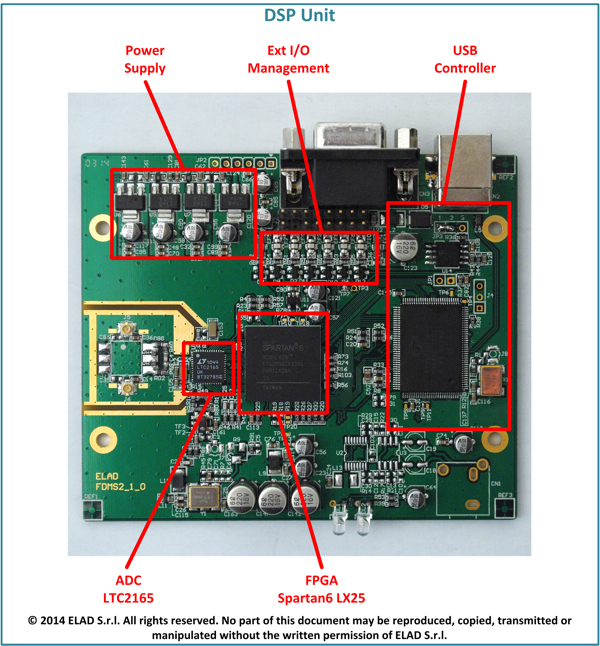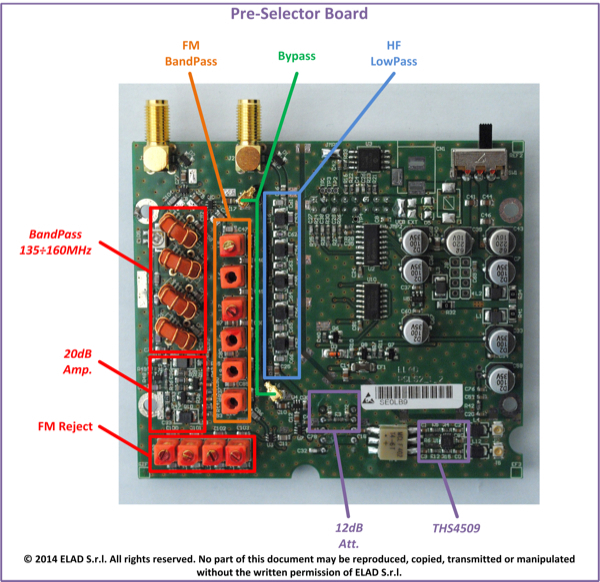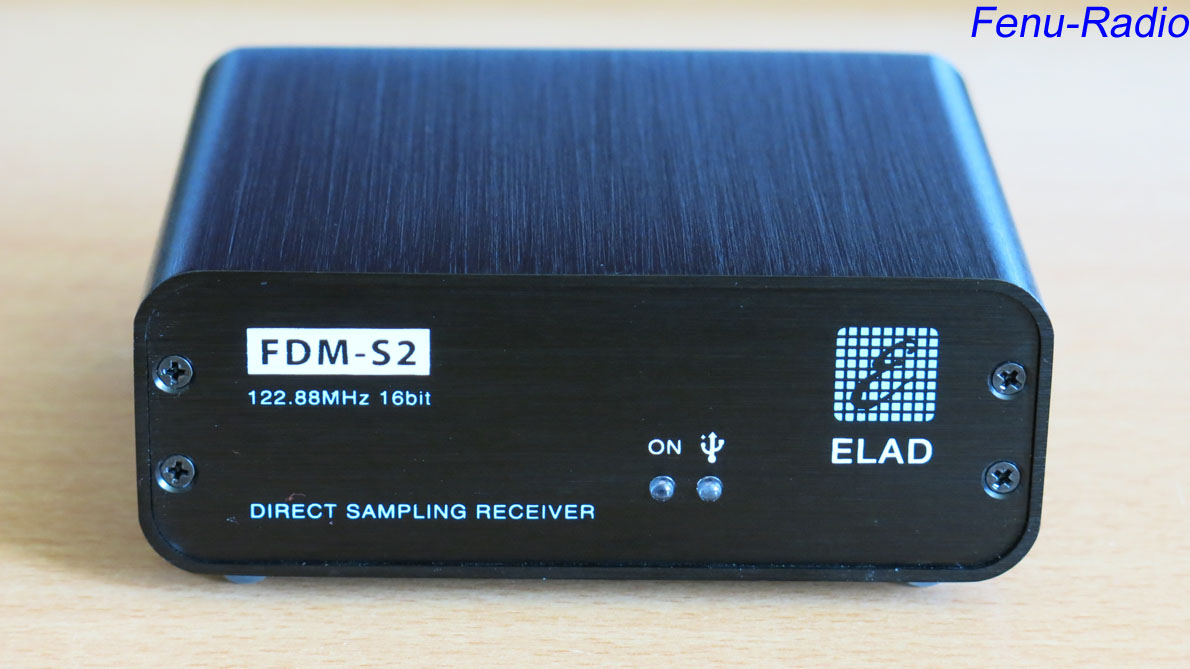|
Elad has become a well-known name in the SDR world. The small Italian company based in Caneva, north of Venice, has contributed its share to the SDR development in recent years. Elad does also offer interesting antenna splitters and distributors. The FDM-S2 became available in early 2014 and sparked an interest in the shortwave listener community since its release. It is the direct successor of the FDM-S1 which was quite successful. The FDM S2 should be even better! The most important data:
Inside of FDM-S2
With kind permission of ELAD Software SW2 The new software looks very similar to the old SW1. A few additional functions give a professional touch to the software. The highlights of the SW2:
The most interesting feature are the four independent virtual receivers. It is possible to set these receivers at four points in the visible spectrum. A 5Mhz spectrum can contain up to three shortwave broadcasting bands. To compare reception you can put a receiver in each of the three bands and compare reception quality. Each of the four receivers stores the last used frequency, mode, bandwidth, volume, squelch, etc. Also the band preset buttons that are freely configurable in the menu are a good idea. So you can program your own "shortcuts". A recording function must not be missed. The SW2 has an easy to use scheduler, where you can program multiple recording times, much like a VCR. The spectrum or audio recordings can then be played at the desired point in SW2. The spectrum recordings can be tuned as if you were listening live. As in SW1, four different frequency databases can be displayed in the spectrum. One database can be created by the user and can contain an unlimited number of frequencies and can be displayed in the spectrum. Not to mention, the freely scalable spectrum! The SW2 has two separate windows in which the audio signal and the IF signal can be processed. It's a pity that the IF window doesn't allow bandpass tuning in AM mode! The next downside is the lack of choice of the sidebands in AM synchronous mode. The controls on the right side and the red main frequency display are well too small. On a high resolution screen the controls are poorly visible. You have to be very close to the screen to see where to click. The S2 can be controlled remotely over the local network with the "USB Web server software" that only works with the Firefox browser. There would be a lot more to report, but that is out of scope. Best to download the software SW2 and try it out yourself. Download for SW2: SW2- software Download the files which can be played in SW2: WAV files Given the positive feedback in the forums, I was looking forward to the FDM-S2. Franco Milan, the owner of Elad, provided me with a brand new FDM-S2 for unlimited time. So I could test the new device properly without any time pressure. About three weeks I tested the FDM-S2 and compared it mainly with the Perseus. During this time, four software updates were released. One update even corrected bugs that I had reported. This shows the manufacturer's interest to provide a well-functioning software. Great service! The software installation is fast and without problems. After the first start you have to familiarize yourself with the software. Users that already know SW1 have fewer problems of course. The first thing I noticed was the tedious entry of frequency in "Hz" (Hertz). This is unusual. After some searching I found where to switch it to "kHz" in the settings. Many settings can be made in these menus. So for a start I made myself familiar with these. The then current software version was V1.28 and I noticed a few things that needed correction. But now to the reception! Generally speaking the Elad FDM-S2 with its original software SW2 produces slightly less noise than the Perseus. Also the latter using its original software. Low-threshold signals are slightly better readable with the Elad. This is noted in SSB and AM alike. If you want to reduce the noise further, you can help yourself with the digital noise reduction (NR). It works better than the NR of the Perseus. The sensitivity of both contestants seems to be about the same. I couldn't determine any differences. Personal listening habits are what decides the clarity in such a case. Both receivers are really head to head in this respect. What is not so good at the FDM-S2 is its mediocre large signal behavior. On my currently used antennas, a 15m long wire with a 1: 9 Unun, the FenuLoop / HDLA3, Fenu-BigLoop / RLA1B and the Boni whip, the "ADC Clip" display lit up very often. This indicates clipping of the analog / digital converter. In other words, the A / D converter sees too much antenna voltage. But I could not find any distortions or ghost signals. After switching on the attenuator, the ADC clip no longer lit up, however at the cost of reduced sensitivity. It remains to be seen whether this warning is an "early warning" before actual clipping. Very successful, however, is DRM reception. To this end, all that is needed is already integrated in the SW2 software. The DRM schedule has online access to a frequency database and is always up to date. Of course, only if there is an Internet connection. A second window displays the station name and other information that are being broadcast. The FDM-S2 does also receive FM and a section of the VHF band. On FM, the combination S2 & SW2 can fully convince. FM has a very good sound and invites you to linger. RDS is very responsive and works surprisingly well even at weaker stations. The bandwidths on FM are almost infinitely adjustable between 25khz and 192khz. This makes the FDM-S2 interesting for FM DXers. Between high-power transmitters, using a bandwidth of about 60KHz, weaker stations become audible. Due to lack of signals and appropriate antennas, I could not test the VHF range appropriately. A few local radio amateurs were heard a short time. Conclusion:
The FDM-S2
is a very serious opponent for the Perseus! It costs about 300 euros
less, delivers absolutely the same reception performance and even
goes beyond with the fully equipped SW2 software. FM & VHF is
included in the FDM-S2. In the case of the Perseus FM + must be
purchased to receive FM. The SW2 software holds many a function to
be discovered by radio amateurs and SWLs. Only the overload problem
* is a minus point in the otherwise excellent rating! A note at the end: I have been using software versions from V1.25 to V1.28 during my tests. These still contained several bugs. It is to be expected that Elad will further improve the software and new features will be added.
Thanks to Franco for the loan of the
FDM-S2.
|




